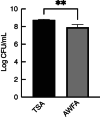An in vitro and ex vivo wound infection model to test topical and systemic treatment with antibiotics
- PMID: 35916629
- PMCID: PMC9804477
- DOI: 10.1111/jam.15756
An in vitro and ex vivo wound infection model to test topical and systemic treatment with antibiotics
Abstract
Aims: This study aimed to develop a wound infection model that could be used to test antibiotic-loaded electrospun matrices for the topical treatment of infected skin and compare the effectiveness of this treatment to systemically applied antibiotics.
Methods and results: 3D-printed flow chambers were made in which Staphylococcus aureus biofilms were grown either on a polycarbonate membrane or explanted porcine skin. The biofilms were then treated either topically, by placing antibiotic-loaded electrospun matrices on top of the biofilms, or systemically by the addition of antibiotics in the growth medium that flowed underneath the membrane or skin. The medium that was used was either a rich medium or an artificial wound fluid. The results showed that microbial viability in the biofilms was reduced to a greater extent with the topical electrospun matrices when compared to systemic treatment.
Conclusions: An ex vivo infection model was developed that is flexible and can be used to test both topical and systemic treatment of wound infections. It represents a significant improvement over previous in vitro models that we have used to test electrospun membranes.
Significance and impact of the study: The availability of a relatively simple wound infection model in which different delivery methods and dosage regimes can be tested is beneficial for the development of improved treatments for wound infections.
Keywords: Staphylococcus aureus; antibiotics; electrospinning; wound dressing; wound infection model.
© 2022 The Authors. Journal of Applied Microbiology published by John Wiley & Sons Ltd on behalf of Society for Applied Microbiology.
Conflict of interest statement
The authors have no conflicts of interest to declare.
Figures







Similar articles
-
Electrospun Zein/PCL Fibrous Matrices Release Tetracycline in a Controlled Manner, Killing Staphylococcus aureus Both in Biofilms and Ex Vivo on Pig Skin, and are Compatible with Human Skin Cells.Pharm Res. 2016 Jan;33(1):237-46. doi: 10.1007/s11095-015-1782-3. Epub 2015 Sep 3. Pharm Res. 2016. PMID: 26337770 Free PMC article.
-
Development of In Vitro and Ex Vivo Biofilm Models for the Assessment of Antibacterial Fibrous Electrospun Wound Dressings.Mol Pharm. 2023 Feb 6;20(2):1230-1246. doi: 10.1021/acs.molpharmaceut.2c00902. Epub 2023 Jan 20. Mol Pharm. 2023. PMID: 36669095 Free PMC article.
-
Evaluation of short exposure times of antimicrobial wound solutions against microbial biofilms: from in vitro to in vivo.J Antimicrob Chemother. 2018 Feb 1;73(2):494-502. doi: 10.1093/jac/dkx391. J Antimicrob Chemother. 2018. PMID: 29165561 Free PMC article.
-
Development of an Experimental Ex Vivo Wound Model to Evaluate Antimicrobial Efficacy of Topical Formulations.Int J Mol Sci. 2021 May 10;22(9):5045. doi: 10.3390/ijms22095045. Int J Mol Sci. 2021. PMID: 34068733 Free PMC article.
-
Development of Chitosan-Based Hydrogel Containing Antibiofilm Agents for the Treatment of Staphylococcus aureus-Infected Burn Wound in Mice.AAPS PharmSciTech. 2020 Jan 2;21(2):43. doi: 10.1208/s12249-019-1537-2. AAPS PharmSciTech. 2020. PMID: 31897806
Cited by
-
Broad-spectrum antimicrobial properties of linalool: supporting its pharmacological use in chronic wound infections by pathogens within the ESKAPE group and polymicrobial biofilms.World J Microbiol Biotechnol. 2025 Mar 10;41(3):99. doi: 10.1007/s11274-025-04317-7. World J Microbiol Biotechnol. 2025. PMID: 40063328
-
The Wound Reporting in Animal and Human Preclinical Studies (WRAHPS) Guidelines.Wound Repair Regen. 2025 Jan-Feb;33(1):e13232. doi: 10.1111/wrr.13232. Wound Repair Regen. 2025. PMID: 39639458 Free PMC article.
-
Imidazoles and Quaternary Ammonium Compounds as Effective Therapies against (Multidrug-Resistant) Bacterial Wound Infections.Antibiotics (Basel). 2024 Oct 10;13(10):949. doi: 10.3390/antibiotics13100949. Antibiotics (Basel). 2024. PMID: 39452215 Free PMC article.
-
Early fibrin biofilm development in cardiovascular infections.Biofilm. 2025 Feb 7;9:100261. doi: 10.1016/j.bioflm.2025.100261. eCollection 2025 Jun. Biofilm. 2025. PMID: 40034339 Free PMC article.
-
Investigating the Efficacy of Amoxicillin-Broccoli Combination in Combating Multidrug-Resistant Staphylococcus aureus Infection.Curr Microbiol. 2025 Jun 18;82(8):338. doi: 10.1007/s00284-025-04316-9. Curr Microbiol. 2025. PMID: 40528121
References
-
- Agostinho, A.M. , Hartman, A. , Lipp, C. , Parker, A.E. , Stewart, P.S. & James, G.A. (2011) An in vitro model for the growth and analysis of chronic wound MRSA biofilms. Journal of Applied Microbiology, 111, 1275–1282. - PubMed
-
- Agwuh, K.N. & MacGowan, A. (2006) Pharmacokinetics and pharmacodynamics of the tetracyclines including glycylcyclines. The Journal of Antimicrobial Chemotherapy, 58, 256–265. - PubMed
-
- Akiyama, H. , Kanzaki, H. , Tada, J. & Arata, J. (1996) Staphylococcus aureus infection on cut wounds in the mouse skin: experimental staphylococcal botryomycosis. Journal of Dermatological Science, 11, 234–238. - PubMed
-
- Alhusein, N. , Blagbrough, I.S. , Beeton, M.L. , Bolhuis, A. & De Bank, P.A. (2016) Electrospun Zein/PCL fibrous matrices release tetracycline in a controlled manner, killing Staphylococcus aureus both in biofilms and ex vivo on pig skin, and are compatible with human skin cells. Pharmaceutical Research, 33, 237–246. - PMC - PubMed
-
- Alhusein, N. , Blagbrough, I.S. & De Bank, P.A. (2013) Zein/polycaprolactone electrospun matrices for localised controlled delivery of tetracycline. Drug Delivery and Translational Research, 3, 542–550. - PubMed
MeSH terms
Substances
LinkOut - more resources
Full Text Sources
Medical
Molecular Biology Databases
Research Materials

